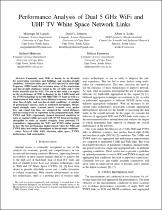JavaScript is disabled for your browser. Some features of this site may not work without it.
- ResearchSpace
- →
- Research Publications/Outputs
- →
- Conference Publications
- →
- View Item
| dc.contributor.author |
Lamola, MM

|
|
| dc.contributor.author |
Johnson, DL

|
|
| dc.contributor.author |
Lysko, Albert A

|
|
| dc.contributor.author |
Maliwatu, R

|
|
| dc.contributor.author |
Densmore, M

|
|
| dc.date.accessioned | 2020-04-12T10:06:33Z | |
| dc.date.available | 2020-04-12T10:06:33Z | |
| dc.date.issued | 2019-08 | |
| dc.identifier.citation | Lamola, M.M. et al. 2019. Performance analysis of dual 5 GHz WiFi and UHF TV white space network links. IEEE Wireless Africa Conference 2019, Pretoria, 18-20 August 2019 | en_US |
| dc.identifier.isbn | 978-1-7281-3618-9 | |
| dc.identifier.isbn | 978-1-7281-3619-6 | |
| dc.identifier.uri | DOI: 10.1109/AFRICA.2019.8843406 | |
| dc.identifier.uri | https://ieeexplore.ieee.org/abstract/document/8843406 | |
| dc.identifier.uri | http://hdl.handle.net/10204/11406 | |
| dc.description | Copyright: 2019 IEEE. Due to copyright restrictions, the attached PDF file only contains the preprint of the published version. For access to the published version, please consult the publisher's website. The definitive version of the work is published at https://ieeexplore.ieee.org/abstract/document/8843406 | en_US |
| dc.description.abstract | Commonly used WiFi is known to be ill-suited for penetrating vegetation and buildings and non-line-of-sight conditions. Television white space (TVWS) operates in ultra-high frequency (UHF) bands that overcome many of the penetration and line-of-sight challenges found in the 2.4 GHz and 5 GHz bands normally used by WiFi. The aim of this study is to report on the performance of WiFi technology in the 5 GHz band and the TVWS technology in the 600 MHz UHF TV band as well as a combination of both radios in two different scenarios, short-range clear line-of-sight, and non-line-of-sight conditions. A number of performance metrics, such as estimated throughput, bitrate, signal strength, noise, transmit power, transmit error, packet loss, and round trip time, are compared for varied distances and increasing levels of vegetation in the propagation path. Both TVWS and WiFi experiments showed increased sensitivity to noise as channel widths increased with TVWS being particularly susceptible to noise in nearby channels from powerful TV transmitters. Aggregating the WiFi and TVWS radios proved to have the best performance improvements when the WiFi and TVWS links had similar throughput in line-of-sight conditions. | en_US |
| dc.language.iso | en | en_US |
| dc.publisher | IEEE | en_US |
| dc.relation.ispartofseries | Worklist;23435 | |
| dc.subject | 5 GHz WiFi | en_US |
| dc.subject | Television white space | en_US |
| dc.subject | TVWS | en_US |
| dc.subject | Performance | en_US |
| dc.subject | Link aggregation | en_US |
| dc.title | Performance analysis of dual 5 GHz WiFi and UHF TV white space network links | en_US |
| dc.type | Conference Presentation | en_US |
| dc.identifier.apacitation | Lamola, M., Johnson, D., Lysko, A. A., Maliwatu, R., & Densmore, M. (2019). Performance analysis of dual 5 GHz WiFi and UHF TV white space network links. IEEE. http://hdl.handle.net/10204/11406 | en_ZA |
| dc.identifier.chicagocitation | Lamola, MM, DL Johnson, Albert A Lysko, R Maliwatu, and M Densmore. "Performance analysis of dual 5 GHz WiFi and UHF TV white space network links." (2019): http://hdl.handle.net/10204/11406 | en_ZA |
| dc.identifier.vancouvercitation | Lamola M, Johnson D, Lysko AA, Maliwatu R, Densmore M, Performance analysis of dual 5 GHz WiFi and UHF TV white space network links; IEEE; 2019. http://hdl.handle.net/10204/11406 . | en_ZA |
| dc.identifier.ris | TY - Conference Presentation AU - Lamola, MM AU - Johnson, DL AU - Lysko, Albert A AU - Maliwatu, R AU - Densmore, M AB - Commonly used WiFi is known to be ill-suited for penetrating vegetation and buildings and non-line-of-sight conditions. Television white space (TVWS) operates in ultra-high frequency (UHF) bands that overcome many of the penetration and line-of-sight challenges found in the 2.4 GHz and 5 GHz bands normally used by WiFi. The aim of this study is to report on the performance of WiFi technology in the 5 GHz band and the TVWS technology in the 600 MHz UHF TV band as well as a combination of both radios in two different scenarios, short-range clear line-of-sight, and non-line-of-sight conditions. A number of performance metrics, such as estimated throughput, bitrate, signal strength, noise, transmit power, transmit error, packet loss, and round trip time, are compared for varied distances and increasing levels of vegetation in the propagation path. Both TVWS and WiFi experiments showed increased sensitivity to noise as channel widths increased with TVWS being particularly susceptible to noise in nearby channels from powerful TV transmitters. Aggregating the WiFi and TVWS radios proved to have the best performance improvements when the WiFi and TVWS links had similar throughput in line-of-sight conditions. DA - 2019-08 DB - ResearchSpace DP - CSIR KW - 5 GHz WiFi KW - Television white space KW - TVWS KW - Performance KW - Link aggregation LK - https://researchspace.csir.co.za PY - 2019 SM - 978-1-7281-3618-9 SM - 978-1-7281-3619-6 T1 - Performance analysis of dual 5 GHz WiFi and UHF TV white space network links TI - Performance analysis of dual 5 GHz WiFi and UHF TV white space network links UR - http://hdl.handle.net/10204/11406 ER - | en_ZA |






